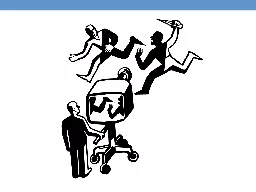

To explore the difference between reality and representation in media texts Defining representation What does representation mean The portrayal of someone or something in a particular way ID: 464646
Download Presentation The PPT/PDF document "Reality vs. Representation" is the property of its rightful owner. Permission is granted to download and print the materials on this web site for personal, non-commercial use only, and to display it on your personal computer provided you do not modify the materials and that you retain all copyright notices contained in the materials. By downloading content from our website, you accept the terms of this agreement.
Slide1Slide2
Reality vs. Representation
To explore the difference between reality and representation in media textsSlide3Slide4
Defining representation
What does
representation
mean?
The
portrayal
of someone or something in a
particular way
or as being of a
certain nature
What are the meanings of the underlined words?
How do the underlined words present problems?Slide5
How are people, places & objects represented in this advert?
People
Family
Generational differences
; Parents are bland and children are exciting
Careless/out of control
mother
who is responsible for the family’s domestic needsA father who is in control and responsible for planning funSon is following the father’s roleMiddle class family Slide6
How are people, places & objects represented in this advert?
Places/objects
Large car connotes
wealth
(affordable for middle class audiences)
Skoda is claiming that it has created an
o
rdinary family car with a sports car = speedOrdinary versus extraordinary. Active props appear in the colour of the car (extraordinary
). Other props appear in grey to blend into the blandness
of ordinary life. Slide7
Representation of people
How true is this
portrayal
of students?
What are the differences between
the
nature
of students in this
image and
reality?
Why have students been represented in this
particular way?Slide8
Stereotypes
A
widely held
but
fixed
and
oversimplified image or idea of a particular type of person or thingWhat are the meanings of the underlined words?How do the underlined words present problems?Slide9
Stereotypes
Match the images to the appropriate words. What other words could stereotypically represent the image?
Athlete
Father
Geek/Nerd
Grandfather
Mother
Teacher
What fixed / oversimplified traits do they have?
How do you know this?Why are these traits considered as “widely held” views?
Who benefits from portraying groups of people in this manner?Slide10
StereotypesSlide11
Ideologies
Aside from using stereotypes, media texts also promote a society’s ideologies (Ideologies are a set of
beliefs
,
values
and
attitudes)
. Capitalist Heterosexual
Patriarchal
FamilialPromotion of mixed sex relationships (male and female)
The importance of money and status
The promotion of the family unit and the basis of a stable society
The promotion of males as the dominant gender in societySlide12
Promotion
of mixed sex relationships (male and female)
Heterosexual
The importance of money and
status
Capitalist
The promotion of the family unit and the basis of a stable
society
Familial
The promotion of males as the dominant gender in society
PatriarchalSlide13
How
far can the
four ideologies
be applied to the following adverts
?Slide14Slide15Slide16Slide17Slide18Slide19
So, what does come first?
Is the media representing people realistically?
Or
Are people copying/adapting their
behaviour
according to how they view themselves in the media?